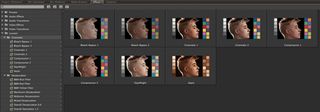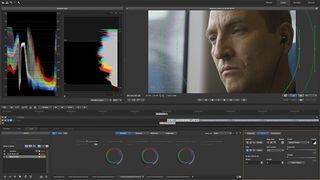20 steps to video editing with power and speed
Get Adobe's Premiere Pro CC and Speedgrade CC working in harmony and you're on the road to streamlined colour and media management. Learn how with these 20 pieces of info about each tool.
Streamlined colour grading, improved media management, and the ability to sync your settings and shortcuts to any edit machine in the world makes Premiere Pro CC an editor's dream. Integrate SpeedGrade CC and update both tools regularly through your Creative Cloud membership, and you the ability to quickly colour-correct or add vibrant looks to your footage.
Premiere Pro: A new video-editing workflow
Premiere Pro CC is a beast of a video editing tool. Not only does it bring ace new features like a redesigned timeline and the Lumetri Deep Color Engine, it also works brilliantly with other Creative Cloud apps so your editing workflow is as smooth as possible.
01. Link and locate
When you're working on a big production, it's likely that you'll have loads of clips - and it's easy to lose track of files and backups saved on multiple drives. Premiere CC's Link & Locate feature helps you track down your clips quickly, making media management - and your productions - more efficient. And efficiency is one of the key benefits of Creative Cloud.
02. Sync your settings
Want to have your keyboard shortcuts and settings with you at all times? Well, now you can. By syncing settings through Creative Cloud you can walk into any edit suite in the world and all your customised settings - including workspaces and keyboard shortcuts - will be exactly where you want them to be. Great, huh?
03. High-fidelity interchange
If there's ever a feature of Premiere CC that sounds cool, this is it. Essentially, High-fidelity interchange enables you to get greater accuracy when importing or exporting Avid or Final Cut Pro projects. AAF import is more accurate, with improved support for DNxHD media. OK, it sounds cooler than it is, but it's nevertheless very handy.
04. Adobe Story panel
Adobe Story Plus - which is included with a Creative Cloud membership - is a scriptwriting tool. And with the Story panel in Premiere CC you can import scripts and the associated metadata. You can also quickly navigate to specific scenes, locations, dialogue, and characters as you edit. Perfect for indie filmmakers.
05. Lumetri Deep Color Engine

With the new Lumetri Deep Color Engine you can quickly apply preset colour grades in Premiere Pro CC. With the new Looks browser, you can preview and add looks from Adobe SpeedGrade very easily - it's as easy as adding any other effect, in fact. You can import LUTs (Look Up Tables) from other systems, as well. This all adds up to a great look for your footage.
Get the Creative Bloq Newsletter
Daily design news, reviews, how-tos and more, as picked by the editors.
06. Mezzanine codecs, native formats
Industry-standard mezzanine codecs are built in to Adobe Premiere CC. You can edit cross-platform with Apple ProRes on Mac OS 10.8 and you get cross-platform support for MXF-wrapped Avid DNxHD files. In Premiere CC you can natively edit even more formats thanks to new support for Sony XAVC and Panasonic AVC-Intra 200.
07. Better, faster editing
We all know sped is the essence when it comes to editing video. And luckily, Premiere CC has some great new editing tools to speed up and refine the process. A redesigned timeline heads the new features, with dozens of new shortcuts backing this up. Paste Attributes is a handy feature - meaning you can copy and paste the specific effects you need from one clip to another.
08. New closed captioning support
According to Adobe, the brand new capabilities for importing and manipulating closed captions in Premiere CC have been designed with editors in mind. You can intuitively import, view, edit, adjust positioning and layout, and export media with closed captions - either embedded or as separate files.
09. Better audio control
You can, in Premiere CC, adjust audio clips independently with the Audio Clip Mixer. There's also the TC Electronic Radar Loudness metre for fine-tuning and you can easily load up plugins, such as VST3 and Audio Units.
10. Better project browsing
The improved media browser enables you to find your clips quickly. You can browse existing projects to find the specific sequences and media you need and import them into your current project.
SpeedGrade: Bringing your footage to life
SpeedGrade CC works with the rest of Adobe's Creative Cloud tools in exactly the way you'd think - in harmony. It slots into your Premiere Pro and After Effects CC workflow, providing a familiar and easy way to professionally grade your footage.
11. Connected to Creative Cloud
Like all of Adobe's applications, SpeedGrade is connected to Creative Cloud, meaning you get access to all the latest updates as soon as they are released. SpeedGrade is also familiar to Premiere Pro CC users so it will fit into your video workflow very easily indeed.
12. The Shot Matcher

Want to match the look of several clips? Don't want to spend an horrendous amount of time doing it? Look no further than the Shot Matcher feature. This enables you to automatically correct subtle differences in footage to achieve a consistent feel between shots, within scenes, and across your entire project. Nice.
13. Workflow - expanded
Looking for an example of Adobe's pro video tools working together? Well, you can load SpeedGrade looks in Premiere Pro, and export looks to After Effects or Photoshop. You can also drag EDLs from Premiere Pro onto the SpeedGrade timeline for grading and finishing.
14. Mercury Transmit
With Mercury Transmit, you can grade your footage on reference-quality external monitors with confidence. Support for selected SDI output cards such as AJA and Matrox lets you view colour-critical work with the complete accuracy you need.
15. Snapshot browser
The Snapshot browser is also pretty cool - and a new addition to SpeedGrade CC. With it you can access graded stills of your work so you can use them as reference. Of course, you could work up a look in Photoshop and then import a still as a JPEG.
16. Layer-based grading power
If you're used to colour correction in Photoshop, grading in SpeedGrade will be a cinch. You can easily organise your colour correction workflow by using layers. Keys and masks help you fine-tune your work and custom look layers help add visual impact. There's also a load of presets for quick corrections.
17. A better UI

The SpeedGrade user interface has been completely redesigned and is now more familiar to Premiere Pro users. In addition, an enhanced grading panel has more controls, and the new Media Browser and Look Manager give easy and fast access to shots and grades.
18. Lumetri Deep Colour Engine
The Lumetri Deep Color Engine uses 32-bit floating-point processing, so you can make your shots look their best. You can easily (and quickly) natively grade RAW and high dynamic range material from digital cinema cameras in real time.
19. Emulate film stock
Want your footage to look like a certain stock? Or even classic film? No problem. With SpeedGrade's film stock emulation presets you can do just this, in no time at all.
20. Expanded control surface support
With SpeedGrade CC you can work the way you want, whether that's with a standard keyboard and mouse, a trackball or a trackpad. SpeedGrade CC also supports grading panels from Tangent Devices like the Wave, the CP200 and, now, the Element - so it fits into any grading workflow.
These articles were originally published in The Ultimate Guide To Adobe Creative Cloud.
Now read these:
- Best laptops for video editing
- The best video editing software
- Free Photoshop actions to create stunning effects

Thank you for reading 5 articles this month* Join now for unlimited access
Enjoy your first month for just £1 / $1 / €1
*Read 5 free articles per month without a subscription

Join now for unlimited access
Try first month for just £1 / $1 / €1
The Creative Bloq team is made up of a group of design fans, and has changed and evolved since Creative Bloq began back in 2012. The current website team consists of eight full-time members of staff: Editor Georgia Coggan, Deputy Editor Rosie Hilder, Ecommerce Editor Beren Neale, Senior News Editor Daniel Piper, Editor, Digital Art and 3D Ian Dean, Tech Reviews Editor Erlingur Einarsson, Ecommerce Writer Beth Nicholls and Staff Writer Natalie Fear, as well as a roster of freelancers from around the world. The ImagineFX magazine team also pitch in, ensuring that content from leading digital art publication ImagineFX is represented on Creative Bloq.
